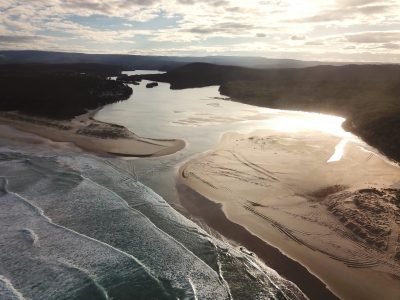Sandy beach morphodynamics – a new book

It is a delight to see a new book that so comprehensively covers the field of beach morphodynamics. Derek Jackson and Andy Short have edited 29 chapters on this topic: Sandy Beach Morphodynamics, Elsevier, Amstersdam,2020, 793pp. The editors have done a magnificent job in bringing together 58 authors to contribute chapters in a systematic attempt to depict processes and forms inherent in beach behaviour. Congratulations also to the publisher who has given us a product laced with clear diagrams and photos.
As the editors explain in their introduction, the concept of morphodynamics as applied to coasts in general and beaches in particular, had its origins at the Coastal Studies Institute, Louisiana State University. Andy, Don Wright, and I spent time at CSI where much energy was invested in the study of coastal systems in different parts of the world. The interaction of process and form from the perspective of both temporal and spatial variability gave rise to the concept which Don and I wrote up in a paper in Progress in Physical Geography in 1977. Don and his colleagues and students at Sydney University between 1974 and 1982 placed considerable emphasis in field studies of sandy beaches. This work helped underpin many studies elsewhere in subsequent years. This book provides insights as to progress since those heady days of the 70s.
One of the clear justifications for a book on this topic is the threat posed to beach systems by climate change and human intervention. As the editors say, “They are one of the most dynamic environments on earth and one of the most responsive, much visible with the naked eye”. Understanding ways in which processes arrange and mobilise sediment and in turn impede the processes as landforms change shape and position defines the interaction, the feedbacks, that lie at the core of morphodynamics. So interestingly the book does not start with a particular process but with materials: beach sand and its origins (Ch.2).
Then we get into wave climates, wave behaviour both outside the surf zone and breaking waves, and tidal processes and effects. This naturally leads to more detail on what is happening in surf and swash zones, on mechanisms of sediment transport before a discussion of aeolian sand transport over beaches (Ch.10). Rips, cusps, and various rhythmic patterns are developed in some detail by a range of authors supported by some excellent illustrations. That beaches made of both sand and gravel are common in many parts of the world and behave in somewhat different ways is depicted in Chapter 14 by Lopez-Ruiz et al. It is pleasing to see the chapters on sandy beaches in estuaries and bays included in this book as too often the focus on dramatic open ocean systems misses those environments where population is concentrated and sensitivity to long-term change may be greater. Chapter 16 by Andy Short on the wave-tide continuum highlights his vast experience in field studies in different environments. There is a series of papers on modelling, shoreline change, preservation of environmental signals in beach deposits, and impacts of extreme events. The importance of post-storm recovery is highlighted in Chapter 22 co-authored by Mitch Harley with an example from 2016 east coast low.
Three chapters (23,24,25) provide excellent coverage of changes to sediment transport linked in various ways to sediment compartments including the way sediments are transported over time both within a compartment (e.g. beach rotation) and between through headland bypassing. Ian Goodwin and colleagues in Chapter 25 expands the time scale in the context of a “time-varying sediment budget”. Chapters 26, 27 and 28 take more of an overview on data, techniques, and the application of “machine learning” in understanding complex environmental systems such as beach morphodynamics.
All these chapters tell us so much about how coastal scientists have gone about studying beach behaviour at different time scales. The editors point to the advances in technologies to measure processes and responses and how more computer power will facilitate analysis of larger data sets allowing better prediction of beach response. In their words “Backed up by in situ measurements and remote-sensing advances the validation tools are there for new modelling studies”.
My own contribution, Chapter 29, is somewhat of an aberration amidst all this wonderful science. The editors invited me to consider challenges in beach management recognising two things, one the dynamic nature of beach systems, and two the contested nature by humans of their use. My experience as a geomorphologist and in coastal policy enabled me to look at various ways governments are responding to pressures on beach use. Thorny legal rights and equity issues emerge at a time when private ownership and associated beachfront development impinge on the fluctuating natural sandy beach ostensibly available as a public good. Climate change is not making life any easier for governments to “balance” contesting interests. However, our knowledge of beach morphodynamics to resolving such issues should be called upon to avoid that terrible curse of “maladaptation”.
Finally I must say how delightful it was to see authors from quite a wide range of countries. Derek and Andy worked extremely hard at ensuring that folk from different institutions and coastal specialities were included. Australia was quite well represented, both from the older generation and those who are now making their name in coastal studies. Hannah Power and Ana Vila-Concejo contributed two papers. There were quite a few joint papers with contributors from different institutions which highlights the strong collegiate interest in addressing problems of beach morphodynamics. Well done.
Bruce Thom
Words by Prof Bruce Thom. Please respect the author’s thoughts and reference appropriately: (c) ACS, 2020, for correspondence about this blog post please email austcoastsoc@gmail.com
#166


 Cliffs in the Narrabeen Group, Sydney
Cliffs in the Narrabeen Group, Sydney